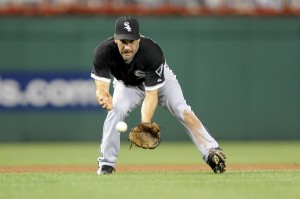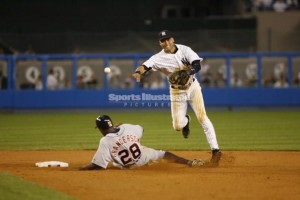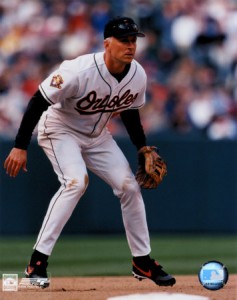Common shortstop mistakes
December 29, 2012 by Coach McCreary
Filed under Shortstop
This week, I have been reposting a series I did way back at the start of Baseball By The Yard that covers common mistakes players make by position. New posts will begin again on Wednesday, January 2.
Next up … common mistakes by shortstops!
Charging straight at the ball. This mistake is understandable since that is what younger kids are correctly taught to do at the lower levels. However, as kids get older the game gets faster. Eventually, charging straight at the ball creates problems with timing, footwork, balance, and momentum. All these prevent players from keeping up with the pace of the game. This is true for all infielders but especially for shortstops since they generally have longer throws
and less time in which to do it. The correct way is to get to the right of the ball when you charge. Additionally, the last two steps before catching the ball should be right foot then left foot, in that order. A fielder should not be back in front of the ball until the left foot lands. Staying to the right allows for proper footwork and also creates momentum towards your target. Stepping right foot then left foot puts the ball back in the center and also shifts the body’s momentum to the player’s left (towards 1st base) even before catching the ball. This is what’s happening with Omar Vizquel in the first photo. Fielders can “move through the ball” and never have to stop to catch a grounder and then waste time getting started again. Staying to the right isn’t always possible depending on where and how hard the ball is hit but the best shortstops have practiced it and are quick enough to do it more often.
Catching the ball over the bag on a double play. As stated earlier, the game gets faster as you get older. Turning two a little faster is one of the many little things that can take a shortstop from good to great. Many young shortstops get to the bag on a double play and then stop to receive the feed from the second baseman. They catch the ball right over the bag and then turn to throw to first. Eventually, this isn’t good enough. When the ball is hit, the shortstop
should sprint to within 5 feet of the bag. He then “sneaks up on the bag” using shorter, more choppy steps to read the throw. If the throw is on target, he then steps across the bag with his left foot to catch the ball. In effect, he is catching the ball about 2-4 feet on the right field side of second base. This enables him to catch the ball 2-4 feet sooner than if he caught it over the bag. He also has decreased the distance of his throw to first by a few feet. As the photo to the right shows, Jeter is farther away from the base path making the play safer as well. The most difficult part to this play is the “sneaking up on the bag” and reading the throw. Shortstops have to be careful not to assume the throw is going to be on target and come across the bag too soon. Slowing down (not stopping) to read the throw and then speeding up to get through the bag takes a lot of practice and timing but the better ones do it.
Only one arm angle. To be a premier shortstop, a player needs to practice and be comfortable with throwing with every possible arm angle. From throwing right over the top all the way down to practically scraping his knuckles on the ground, different situations call for different arm angles in order to maximize the combination of quickness and arm strength. Throwing at one arm angle all the time (side arm, ¾, over the top, etc.) limits a shortstop’s ability to handle any play that comes along. Generally speaking, when a shortstop needs a longer or stronger throw (relays or plays in the hole), an over-the-top arm angle should be used. Short throws (like feeds to 2nd base) that require more quickness than arm strength allow for lower angles. Turning a double play calls for a combination of arm strength and quickness so a ¾ angle or side arm works best (see Jeter photo). Practice and train your arm to be comfortable with every angle.
“Dropping an anchor.” Too many shortstops pick one spot where they are comfortable playing and position themselves there virtually every pitch. That’s called “dropping an anchor” because the player doesn’t move from that spot. Some may have two spots – one for a lefty hitter and one for a righty. Premier shortstops (and other fielders as well) consider many variables and change their positioning as a result, sometimes changing every pitch. This is
especially true for a shortstop since they have a lot of ground to cover. The movements may not be extreme but they do occur. For a fantastic visual of this, click here. Premiere shortstops also develop the ability to “lean” depending on who is batting, the count, and the pitch. Here is an example. A right-handed pull hitter swings and misses badly on two slow curveballs in the dirt low and away. The next pitch called for is a hard fastball on the inside corner. 99.9% of the time, that hitter will never pull that pitch in that location. The shortstop might “lean” up the middle on the pitch to account for this. In doing so, a shortstop can pick up an extra step or two of range if they lean correctly. This, of course, takes practice, experience, and a good awareness of what’s going on around you. This is what coaches and scouts mean when they say a fielder has “good instincts.” However, it is not all “instinct.” It can be practiced, learned, and developed like any other skill.
Tomorrow: Third Base








Leave a Reply